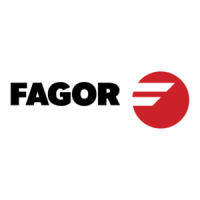Programming manual.
CNC 8070
1.
CREATING A PROGRAM.
Program block structure.
·36·
(REF: 1709)
1.3.1 Programming in ISO code.
ISO-coded functions consist of letters and numbers. The letters are "N", "G", "F", "S", "T",
"D", "M", "H", "NR" plus those identifying the axes.
The numbers include digits "0" through "9", the "+" and "-" signs and the decimal point ".".
Likewise, the numerical format may be replaced by a parameter, variable or arithmetic
expression whose result is a number.
Programming allows blank spaces between letters, numbers and a sign as well as not using
the sign with positive values.
Block structure.
A block may have the following functions, but needs not contain all of them. The data has
no set order, it may be programmed anywhere in the block. The only exception being the
block-skip condition and the block identification which must always be programmed at the
beginning.
·/· Block skip condition.
If the block-skip mark is active, the CNC will skip the blocks having this character (not
executing them) and will go on to the next block.
The CNC reads several blocks ahead of the one in execution, in order to calculate in advance
the path to travel. The block-skip condition is examined at the time when the block is read.
·N· Block identification.
The block identification must be programmed when the block is used as the destination of
references or jumps. In this case, it is recommended to program it alone in the block. It may
be represented in two ways:
• The letter "N" followed by the block number (0-4294967295) and the ":" character (only
when the label is used as the destination of a block jump); they need not follow a particular
order or be consecutive.
If the label is not a jump target and is programmed without ":", it may go in any position
of the block, not necessarily at the beginning.
• "[<name>]" type labels, where <name> may be up to 14 characters long and may consist
of uppercase and lowercase characters as well as numbers (no blank spaces are
allowed).
Both types of data may be programmed in the same block.
·G· Preparatory functions.
G functions set the geometry and work conditions such as linear and circular interpolations,
chamfers, canned cycles, etc. See "1.5 List of "G" functions." on page 40.
·X..C· Coordinates of the point.
These functions set the movement of the axes. See "1.4 Programming of the axes." on page
39.
Depending on the units, the programming format will be:
• In millimeters, format ±5.4 (5 integers and 4 decimals).
• In inches, format ±4.5 (4 integers and 5 decimals).
·F· Axis feedrate.
The feedrate is represented by the letter "F" followed by the desired feedrate value.
/N—G—G—X..C—F—S—T—D—M—H—NR—
N10: X12 T1 D1
[CYCLE] G81 I67
X34 N10 S100 M3

